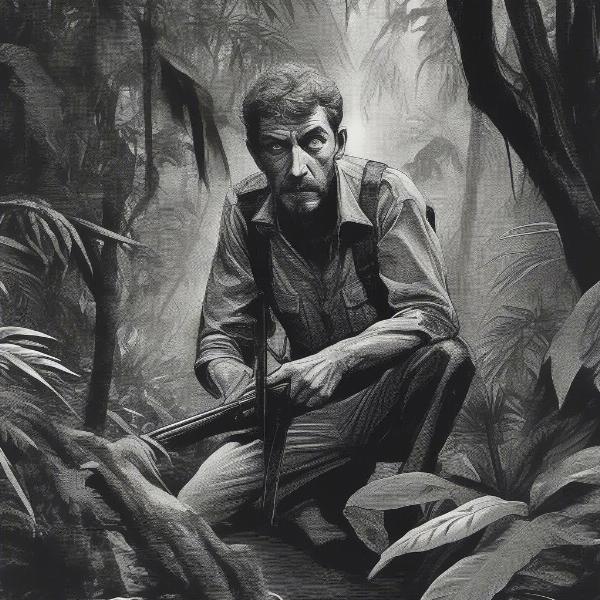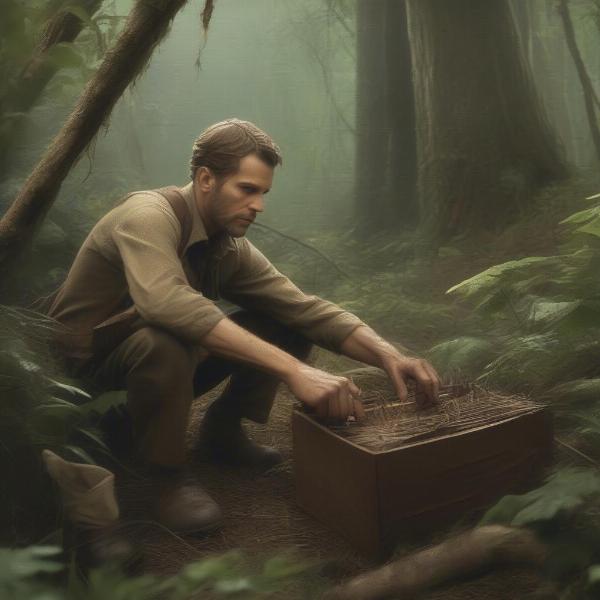Sanger Rainsford is the main character in Richard Connell’s thrilling short story, “The Most Dangerous Game.” This tale of survival pits Rainsford, a renowned big-game hunter, against a cunning and formidable opponent on a remote, mysterious island.
As a celebrated hunter, Rainsford initially views the world through the lens of the predator. His perspective drastically shifts, however, when he becomes the prey of General Zaroff, the island’s enigmatic owner. This experience forces Rainsford to confront the ethical implications of hunting and the true meaning of fear and survival. He is tested both physically and mentally, pushing him to the limits of his endurance and resourcefulness. Rainsford’s journey from hunter to hunted forms the core of the story’s suspense and explores the complex relationship between humans and the wild. This dramatic shift in perspective forces him to re-evaluate his own beliefs about hunting and the value of human life. This conflict between Rainsford and Zaroff creates a powerful narrative tension, driving the story forward and keeping readers on the edge of their seats.
Understanding Rainsford: Hunter Turned Hunted
Rainsford’s character is essential to understanding the core themes of “The Most Dangerous Game.” At the beginning of the story, he’s portrayed as a highly skilled and experienced hunter, confident in his abilities and seemingly unaffected by the act of killing. However, his encounter with Zaroff turns his world upside down. Suddenly, he’s no longer the one in control, and the thrill of the hunt becomes a fight for his life.
This transformation allows Connell to explore the psychological impact of being hunted. Rainsford’s fear, desperation, and ultimately, his cunning, are all brought to the forefront as he struggles to outwit Zaroff. He is forced to use all his knowledge and skills, not to conquer, but to survive. This dynamic adds depth and complexity to the story, pushing beyond a simple adventure tale to examine the human condition under extreme pressure. The narrative prompts readers to consider their own perspectives on hunting and the delicate balance of power between hunter and prey. Just as video games can offer immersive experiences, much like discussed in our article how to save game in hogwarts legacy, “The Most Dangerous Game” plunges readers into Rainsford’s desperate fight for survival.
 Sanger Rainsford, the protagonist, faces a deadly game of survival.
Sanger Rainsford, the protagonist, faces a deadly game of survival.
The Psychology of the Hunted: Rainsford’s Transformation
Rainsford’s character arc is a compelling study in human adaptability and resilience. The confident hunter becomes the resourceful prey, forced to think strategically and utilize his environment to his advantage. He sets traps, uses his knowledge of the island’s terrain, and even employs psychological tactics to outsmart Zaroff. This shift highlights the primal instincts that kick in when survival is at stake, showcasing the human capacity to adapt and overcome even in the direst circumstances. He is not just reacting to Zaroff’s pursuit, but actively strategizing and fighting back, utilizing the same skills that once made him a successful hunter.
How does Rainsford’s experience change him?
Rainsford’s ordeal changes his perception of hunting and the relationship between hunter and prey. While he initially saw hunting as a sport, he comes to understand the fear and desperation of the hunted. This newfound empathy adds a layer of moral complexity to the story, raising questions about the ethics of hunting and the value of life. The experience forces him to confront his own beliefs and question the morality of his previous actions. Does his experience change his views on hunting? While the story doesn’t explicitly answer this question, it leaves readers to ponder the psychological impact of Rainsford’s transformation.
 Rainsford uses his hunting skills to set elaborate traps in the jungle.
Rainsford uses his hunting skills to set elaborate traps in the jungle.
General Zaroff: The Antagonist and the Game
General Zaroff, the antagonist, is a complex and disturbing character who presents a stark contrast to Rainsford. He is a Cossack general with a sophisticated demeanor and a passion for hunting, but his prey of choice is not animals, but humans. This chilling twist establishes the central conflict of the story and sets the stage for a thrilling battle of wits and survival. Zaroff believes that humans, with their capacity for reason, are the most dangerous game to hunt, justifying his cruel and twisted hobby. He sees himself as a connoisseur of the hunt, constantly seeking new challenges and thrills.
Why does Zaroff hunt humans?
Zaroff’s motivation for hunting humans stems from his boredom with traditional hunting and his belief in the superiority of some individuals. He views it as a test of intellect and skill, a way to exercise his predatory instincts on a worthy opponent. His philosophy raises unsettling questions about the nature of humanity and the potential for cruelty. Is he simply a madman, or does he represent a darker side of human nature? The story leaves room for interpretation, allowing readers to grapple with the disturbing implications of Zaroff’s actions. Much like exploring the complexities of character motivations in games, like we did in our piece on will there be a season 2 of darwin's game, understanding Zaroff’s reasoning is key to appreciating the depth of “The Most Dangerous Game.”
The Island Setting: A Character in Itself
The isolated island setting of “The Most Dangerous Game” plays a crucial role in the story’s suspense and atmosphere. The dense jungle, treacherous terrain, and looming chateau create a sense of isolation and danger, mirroring the psychological landscape of both Rainsford and Zaroff. The island’s remoteness and mysterious reputation contribute to the overall sense of unease, making it the perfect backdrop for a deadly game of cat and mouse. The environment becomes another obstacle for Rainsford to overcome, forcing him to rely on his instincts and resourcefulness.
Beyond the Hunt: Exploring Deeper Themes
“The Most Dangerous Game” delves into profound themes that resonate far beyond the surface level of an adventure story. The narrative explores the nature of hunting, the ethics of killing, and the complex relationship between hunter and prey. It also examines the human capacity for both cruelty and compassion, prompting readers to consider the boundaries of morality and the consequences of unchecked power. The story’s enduring popularity lies in its ability to provoke thought and discussion, making it a timeless classic in the thriller genre.
Conclusion
“The Most Dangerous Game” remains a captivating story because of its exploration of complex themes and the compelling dynamic between Sanger Rainsford, the main character, and General Zaroff. Rainsford’s transformation from hunter to hunted highlights the psychological impact of survival and raises profound questions about the ethics of hunting. This suspenseful tale continues to grip readers with its exploration of the human condition under duress and its thought-provoking examination of the relationship between predator and prey.
FAQ
-
Who is the author of “The Most Dangerous Game”?
Richard Connell wrote “The Most Dangerous Game.” -
What type of story is “The Most Dangerous Game”?
It is a thriller/adventure short story. -
Where does “The Most Dangerous Game” take place?
The story takes place on a remote, isolated island in the Caribbean Sea called Ship-Trap Island. -
What is the main conflict in the story?
The main conflict is between Sanger Rainsford and General Zaroff, where Rainsford becomes the hunted in Zaroff’s twisted game. -
What is the significance of the island setting?
The isolated island enhances the sense of danger and suspense, mirroring the psychological states of the characters. -
What are some of the key themes explored in the story?
The story explores themes of hunting, survival, the ethics of killing, and the relationship between hunter and prey. -
What happens at the end of “The Most Dangerous Game”?
While not explicitly stated, it is implied that Rainsford kills Zaroff and sleeps in his bed.

